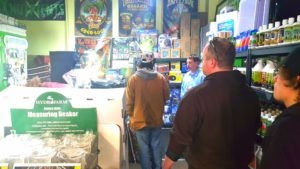By Laurentian Staff Member Sam Horner
Growing fruits and vegetables in northern Minnesota can be a tricky task to accomplish. Greenhouses help to begin and prolong the growing season, but there are still times when winter makes it too hard to grow any plants outside. The Northern Lights Community School YES! team wanted to see if there was a way to circumvent winter, and grow food all year long. The owners at the Duluth Hydroponics store were more than happy to step in and help out the YES! team.
 Owners Brian Boyd and Emily Miketin welcomed the YES! team. Brian and Emily have over seven years of experience in the hydroponics business and were able to share their expertise with the students, many of whom have no experience with hydroponics. Brain explained that hydroponics means working water, or in this instance growing plants without any soil. The plants grow in some sort of medium, and the plants would be either hanging from the roots or submerged in water. With the plants not being able to obtain nutrients from soil, the plants need a new source of nutrients. Essential nutrients are supplied to the plant through the water. Since the plants do not need to work as hard to search for nutrients, the plant is able to grow bigger and faster than it’s counterparts grown in soil gardens. The plants also need 80% less water as compared to regular plantings. Hydroponics is incredibly more water efficient than traditional soil-based planting.
Owners Brian Boyd and Emily Miketin welcomed the YES! team. Brian and Emily have over seven years of experience in the hydroponics business and were able to share their expertise with the students, many of whom have no experience with hydroponics. Brain explained that hydroponics means working water, or in this instance growing plants without any soil. The plants grow in some sort of medium, and the plants would be either hanging from the roots or submerged in water. With the plants not being able to obtain nutrients from soil, the plants need a new source of nutrients. Essential nutrients are supplied to the plant through the water. Since the plants do not need to work as hard to search for nutrients, the plant is able to grow bigger and faster than it’s counterparts grown in soil gardens. The plants also need 80% less water as compared to regular plantings. Hydroponics is incredibly more water efficient than traditional soil-based planting.
Brian then discussed about how the students could become crazy scientists with hydroponics. Many different variables could be manipulated to help the plants grow to their full potential. The amount of carbon dioxide, pH, phosphorous, nitrogen, and potassium are only a few of the variables that can be changed. With some research, the students will be able to figure out how to best manipulate these variables to grow large plants. Along with the differing types of nutrients, there are different hydroponics configurations the students can test out. The three different hydroponic configurations that Brian had were “ebb and flow”, “water culture”, and “aeroponics”. The ebb and flow system consists of a pump sending water to the plants and submerging the roots in water for a given amount of time. When the time is right, the water will return back to the reservoir. In the water culture set up, the roots are always submerged by the water. The lettuce family will grow perfectly in this situation, but other plants do not like to have their roots in water all the time. Aeroponics does not use any type of growing medium other than air. The roots are hanging in the air and out of any water. A device will spray nutrient water onto the roots every few minutes, and this will help them to grow. Brian said that each have their strengths and weaknesses, but that ebb and flow and water culture were the two that he would recommend for the team.
When the tour was wrapping up, the owners left the students with a few last statements. They told them that they would reap what they sow in hydroponics. If the YES! team gives their plants the attention and nutrients that they need, they will gain many wonderful plants. Also, hydroponics can be run with only a little start up money, so this will help the team get the most out of their time and money. Hydroponics may not take over the growing world, but it will only grow from here, The Northern Lights Community School YES! team is excited to start this new endeavor for their school!